Surgeries Offered

Robotic Surgery
Robotic surgery is a minimally invasive technique that uses small incisions and advanced tools to help your surgeon operate with precision. It often results in less pain, quicker recovery, and better outcomes—all while your surgeon stays fully in control.

Laparoscopic Surgery
Traditional minimally invasive surgery uses small incisions and long instruments guided by a camera. The surgeon operates with precision inside the abdomen, often with the help of an assistant to manage the tools.

Robotic Hernia Surgery
A hernia is a tear in the abdominal wall leading to protrusion of internal organs. The most common indication for repair includes pain, discomfort, limiting daily activities, or other symptoms.

Emergency General Surgery
Time-sensitive surgical conditions can be potentially life-threatening, requiring prompt surgical intervention.

Robotic Colon Surgery
A section of the colon is removed and a new connection is fashioned inside the body. This helps to re-establish continuity of the gastrointestinal tract. The robotic platform provides better visualization and improved anastomosis (connection) technology.

Robotic Gallbladder Surgery
Gallbladder disease can cause acute and chronic pain particularly after meals rich in fats. Robotic cholecystectomy (gallbladder) is performed for a variety of conditions including.

Laparoscopic Appendectomy
The appendix is finger sac like structure at the base of the cecum. It becomes problematic when the appendix gets obstructed or infected which can lead to perforation. Prompt appendectomy is the main course of treatment. Indications for appendectomy include

Breast Cancer
Diagnosis starts with a mammogram and a breast examination. This is usually followed by a breast biopsy for identification of breast cancer. We believe in a multidisciplinary approach to breast cancer. Surgical treatment may includes

Colonoscopy
A safe method of examining your Gastroitestinal tract. Guidelines recommend starting screening for colon cancer at age 45. This can be both diagnostic and therapeutic in identifying a variety of conditions such as

Robotic Hiatal hernia repair
A Hiatal Hernia occurs when a portion of the stomach slides into the chest cavity causing pain, reflux or trouble swallowing. A Robotic repair places the stomach in the correct position

Port Placement
A Port is a device implanted under the skin and has direct access to the venous system and useful for frequent infusions

Soft Tissue Mass Excision
Soft tissue masses are lesions that sit under the skin causing pain and discomfort. These lesions can be benign or malignant and may require surgical removal

Hemorrhoid Treatment
Hemorrhoids are enlarged blood vessels in the anus. They are common and, if untreated, can cause prolonged pain and suffering. Hemorrhoids can be internal or external. Treatment starts with lifestyle modification but surgery may be needed

Skin Cancer
Skin cancer is the most common type of cancer. The main types of skin cancer are squamous cell carcinoma, basal cell carcinoma, and melanoma. Melanoma is the most aggressive and surgery can be curative

Abscess or Skin Infection
Skin infections are very common and they often require drainage to achieve adequate source control to allow antibiotics to work. The area usually looks red, warm and filled with fluid. Prompt surgical intervention reduces pain and improves outcomes

Diagnostic Laparoscopy
Many conditions require a minimally invasive exploration of the abdomen to identify and diagnose diseases

Feeding Tube placement
Many conditions cause malnutrition, and access to the gastrointestinal tract is needed to optimize nutrition. Feeding tubes are typically placed in the stomach or small bowel

Skin Graft
A skin graft is a medical procedure where healthy skin is taken from one part of your body and used to cover and heal an area of damaged or missing skin.



